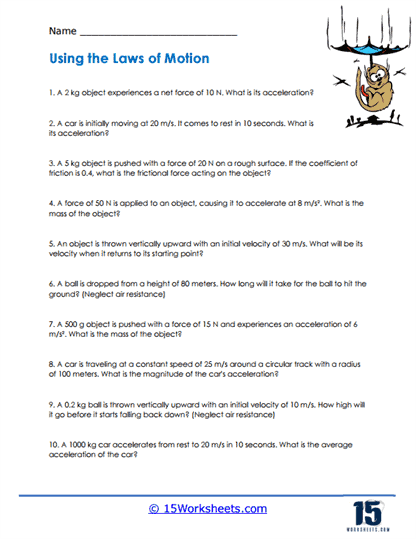Using the Laws of Motion

Worksheet Description
The worksheet is a comprehensive exercise focused on the fundamental principles of Newton’s laws of motion. It provides a series of scenarios, ranging from objects on rough surfaces to balls thrown vertically, and prompts students to use their understanding of forces, acceleration, and motion to solve these problems. The questions touch upon various aspects of motion, such as acceleration due to a net force, the effects of friction, and the behavior of objects in free fall or circular motion. Through these questions, the worksheet endeavors to assess and reinforce students’ grasp of the intricate interplay between force, mass, and acceleration in various settings.
To adeptly solve the problems presented in this worksheet, students must first ensure a solid understanding of Newton’s second law, which describes the relationship between an object’s mass, the net force acting on it, and its acceleration. They should also be familiar with kinematic equations, especially when determining velocities or times in scenarios involving free fall or constant accelerations. Mastery of concepts related to friction, particularly how to calculate frictional force using the coefficient of friction, will be essential for questions where objects are on rough surfaces. Finally, for problems concerning circular motion, understanding how to compute centripetal acceleration becomes crucial.
This worksheet’s overarching objective is to foster a deep understanding of how Newton’s laws of motion can be applied to various real-world scenarios. By challenging students to calculate accelerations, determine forces, or predict the behavior of objects in different contexts, the exercise aims to ensure a thorough grasp of the foundational concepts of physics. Through repetitive practice and engagement with diverse problems, students are trained to internalize the laws of motion and their implications. Ultimately, the worksheet is designed to mold students into adept problem solvers, capable of applying theoretical knowledge to tangible, everyday situations.
